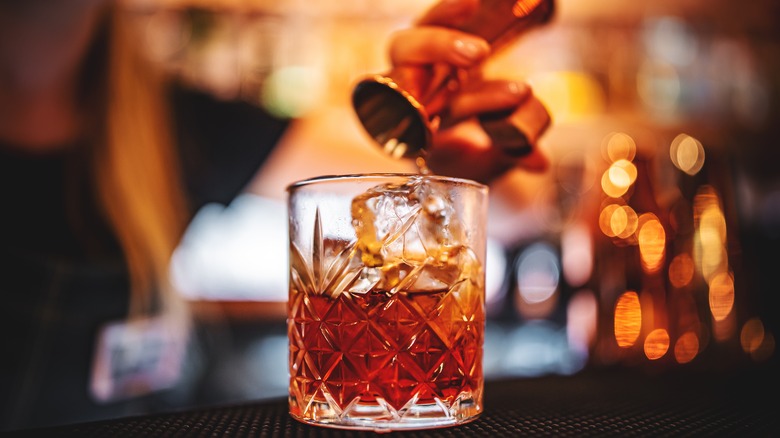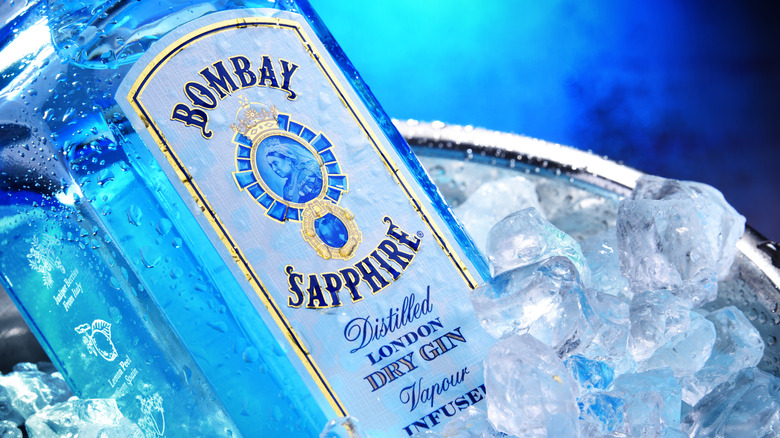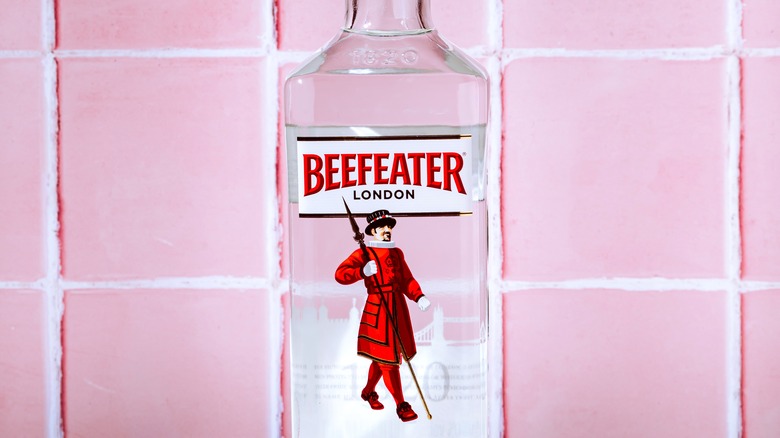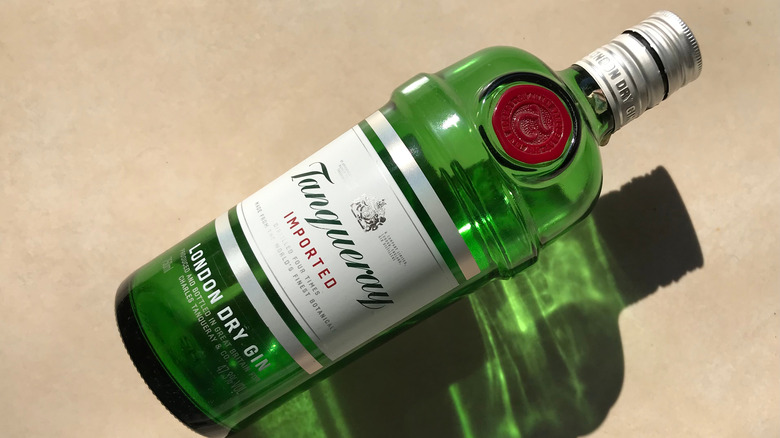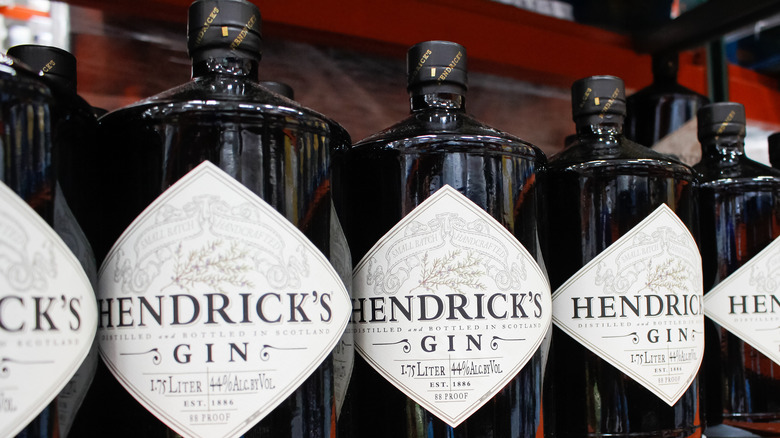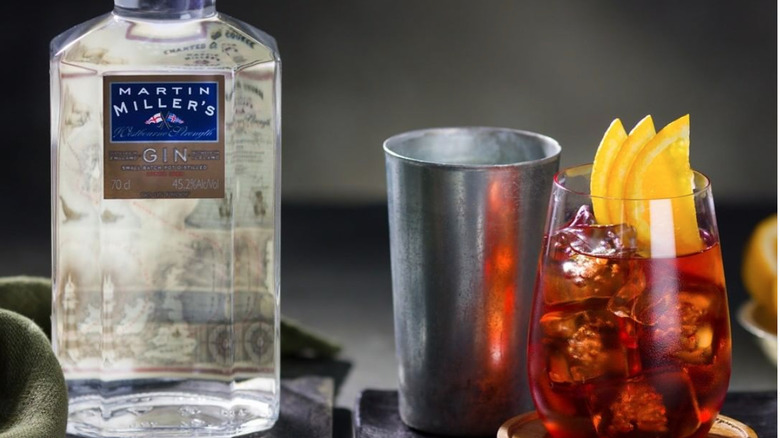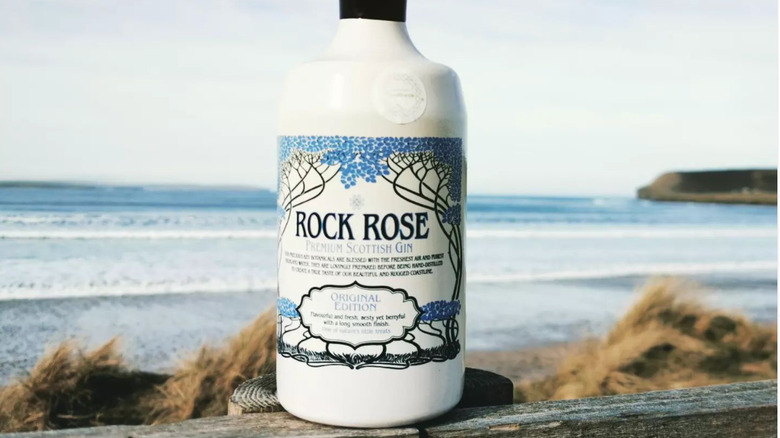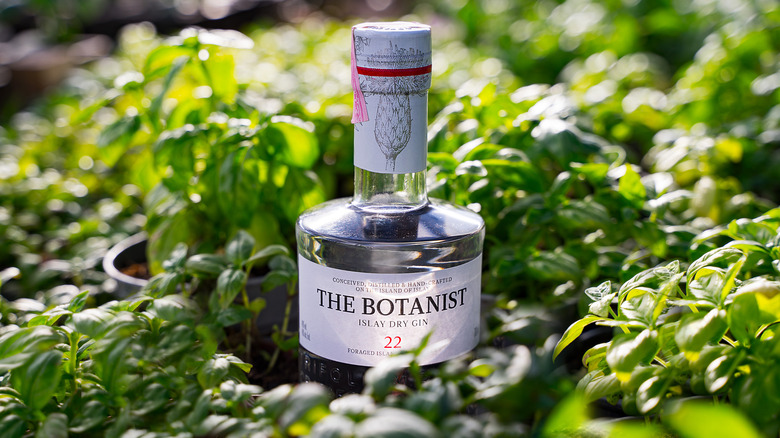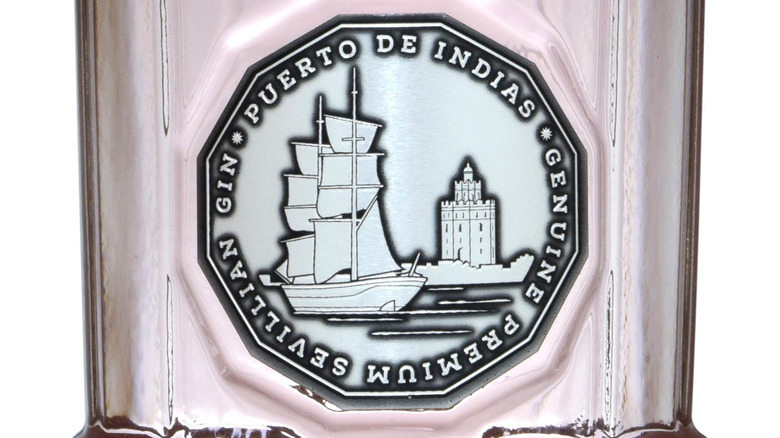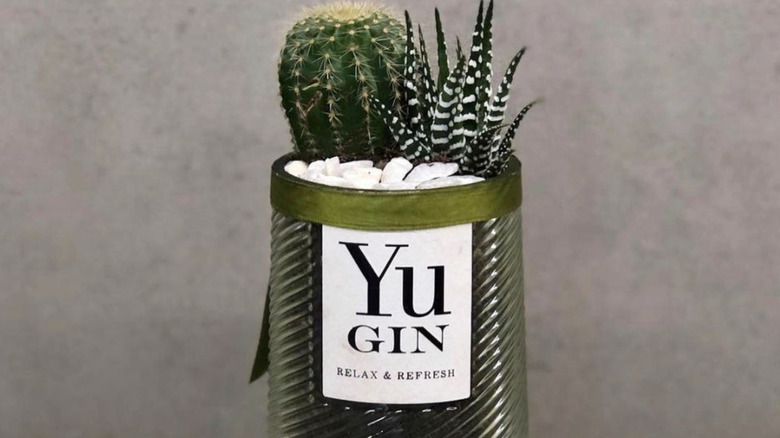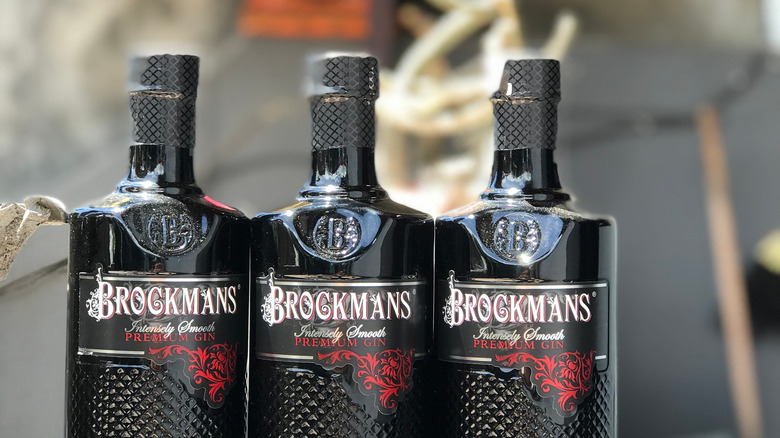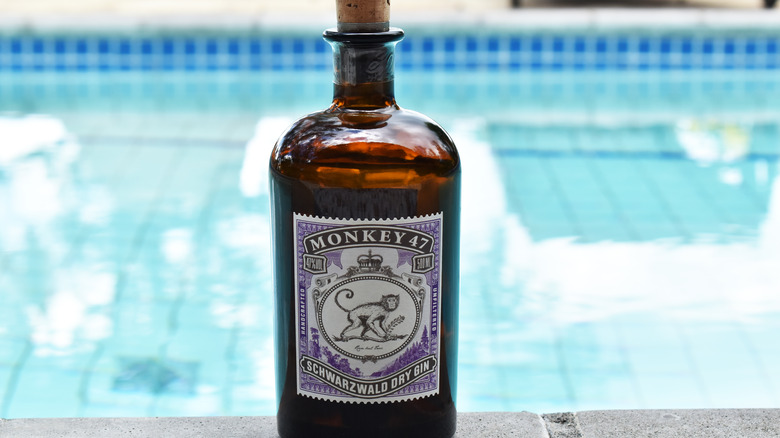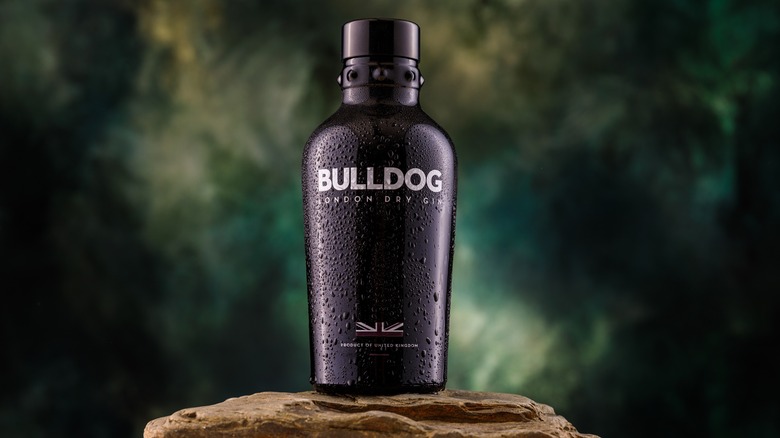12 Best Gins For A Negroni
The elegant Negroni has been enjoying the spotlight for a few years now, but experts know this Italian beauty has been around for more than a century. This classic tipple is the direct offspring of the Americano, a mix of Campari, sweet vermouth, and club soda. History tells us that we have to thank two men for its existence. The first one is Count Camillo Negroni, who stepped into Caffé Cassoni in Florence one fateful day in 1919 and asked the bartender to take his Americano to the next level. The bartender — the second genius in this tale — decided to use gin instead of club soda, and thus was born this aperitivo.
The Negroni's beauty goes well beyond its gorgeous ruby color and pretty garnish, usually an orange slice. Like other classic cocktails, it's deceptively simple — three ingredients poured in equal parts. But this trait not only demands great quality spirits and liquors for its creation; it also calls for a skillful bartender to put them together in perfect balance. And so, to figure out how to choose excellent gins, we found an excellent guide: Seba García, co-owner and head bartender at Presidente Bar in Buenos Aires (ranked No. 21 in The World's 50 Best Bars), and one of the most gifted Negroni-makers on the continent.
Bombay Sapphire
A definite star in the gin category, Bombay Sapphire is one of the brands that has helped this spirit become popular around the world. Yes, the unmistakable blue bottle is part of its success, but the bottle itself tells us why this gin is so good, as it lists the botanicals that it is infused with. The list includes licorice from China, lemon peel and almonds from Spain, and juniper berries from Italy. These botanicals are all hand-selected by Ivano Tonutti, who holds the honorable title of Master of Botanicals, and who travels the world in search of the finest herbs and spices.
To achieve the Bombay effect, up to 10 botanicals are suspended above the spirit in perforated copper baskets during distillation, infusing the vapors that rise during the process with their aromas and flavors. It's worth mentioning that the stills boast human names: Tom and Mary, hailing from the 1830s, and Henry and Victoria, who were brought to the distillery in Laverstoke Mill, England, more recently. Thanks to this process, Bombay Sapphire is as smooth as it is complex, and using it in a Negroni makes the cocktail potent and classically bitter.
Beefeater London Dry Gin
The story of this super British gin begins in 1876. It was founder James Burrough who started this iconic brand in the historic Chelsea Distillery. Since its inception, Beefeater London has moved homes twice and is currently produced in Kensington, a gin temple that still houses original Victorian pot stills and also boasts a botanical room for storing fresh ingredients. Guests can actually visit the Kensington distillery, learn how Beefeater is produced, and stock up on merchandise.
The brand made its stateside debut in 1963 and has been a success ever since. A lot may have changed over the years — the brand was purchased by Pernod Ricard in 2005, but the brand holds on proudly to its legacy. Master Distiller Desmond Payne has overseen product quality since 1995, and the recipe for Beefeater London Dry is still the same one that Burroughs developed back then. The recipe includes nine botanicals, such as juniper, Seville orange, aromatic orris root, and lemon peel. This results in a zesty gin, with a strong presence of juniper that makes it perfect for those who love a classic, elegant Negroni. These botanicals, says Seba, give a Beefeater-based Negroni a very interesting scent.
Tanqueray London Dry Gin
Created by Charles Tanqueray back in 1830, this London dry gin has a bit of a rebellious origin story, notes Travel Distilled, as its creator came from a family of clergymen, but he and his brother Edward decided to take a different road. They wanted to learn about the art and science of gin, so they headed out to the Curries Distillery to study, according to The Spirits Business. Needless to say, this turned out to be the right decision, as Charles's recipe is still used to create Tanqueray London Dry Gin today. He also developed an innovative distillation process, in which he distilled small portions of botanicals into the spirit before distilling a large batch onto the final product.
The spirit that Mr. Tanqueray gave us boasts a bold and beautiful combination of only four botanicals: juniper, angelica root, coriander, and licorice. The very recognizable notes of juniper and citrus make it a great candidate for an aromatic Negroni, which can be upgraded when prepared with Tanqueray No. 10, the brand's citrusy, ultra-premium label.
Seba praises Tanqueray for its versatility and its iconic green bottle, which guests at the bar recognize easily.
Hendrick's
Hailing from the small seaside village of Girvan in Scotland, this delicious, refreshing gin was born in 1999 with a unique personality. The Hendrick's Gin Palace is where the magic happens, thanks to two types of stills used for distillation. The first one is called the Bennett, a copper pot from the 1860s that steeps the 11 botanicals in spirit overnight before the actual distillation, reports Liquor.com. Then comes the Carter-Head, a rare piece from 1948 that steams the botanicals in a basket. The combination of these devices allows for a unique infusion and distillation process.
Master Distiller Lesley Gracie and her team are also to thank when we talk about Hendrick's. Not only did Gracie create the recipe for Hendricks, but she and her team are also in charge of putting together this potion nowadays, using 11 botanicals brought from around the world, including elderflower, chamomile, coriander, and caraway seeds. But it's the essence of rose and cucumber that set Hendrick's apart, granting it fresh and enchanting notes. In fact, Seba says a Hendrick's-based Negroni allows us to change the classic garnish, and use a lime peel or a cucumber slice.
If you're wondering who the brand was named after, it turns out Hendrick was a gardener who worked for the Grant family, notes Liquor.com — Hendrick's is owned by William Grant & Sons — who was particularly talented when it came to growing roses. It was Janet Sheed Roberts, William Grant's granddaughter, who named the gin after him.
Martin Miller's Original
Legend has it that Martin Miller (a modern Renaissance man) and his friends decided to create this premium gin just for the fun of it. They learned about the basics of the production process and set out to develop a classic dry gin using pure Icelandic water and fine botanicals. The result, we think, is fantastic. And so does Seba, who finds Martin Miller's, "Very refined, excellent for a smooth Negroni that is usually ordered by the in-the-know drinker."
To make Martin Miller's original, two pot distillations take place to bring out the properties of citrus and earthy botanicals. According to The Gin is In, the brand separates the citrus from the rest of the botanicals (such as juniper, cinnamon, coriander, and Seville orange) to attend to them separately. This process helps the juniper and citrus shine through, especially on the nose, while a kick of spice will make an appearance on the palate. The final distillate is blended with Icelandic water, so pure that it needs no further distillation. This spring water also gives the spirit a natural bouquet.
Rock Rose
One of the lesser-known Scottish gins that is gaining popularity, Rock Rose hails from the village of Dunnet, which gives the Dunnet Bay distillery its name. This distillery, which is open to the public for tours (and looks incredibly charming), is home to Elizabeth and Margaret, two copper stills that have been designed with traditional copper heads and botanical vapor baskets. After the distillation process, each bottle in the 500-bottle batch is hand-filled, sealed, and labeled.
Claire and Martin Murray, the creators of this gin, experimented with 55 recipes before settling on a winner on August 2014, featuring 18 botanicals like rose root and sea buckthorn, notes The Gin Guide. Upon the first encounter with Rock Rose gin, there are notes of rose, citrus, and cardamom on the nose, followed by berries, florals, and juniper on the palate. Sea buckthorn and lemon sorbet make for an interesting finish that makes it very fresh. Seba finds these notes appealing and says they allow us to play around with the classic Negroni aromas and garnish, perhaps using a slice of lemon instead of orange.
The Botanist
One of Seba's favorites, this London dry gin is made with 22 botanicals that are foraged on the Scottish island of Islay. Apple mint, birch leaves, cinnamon bark, and peppermint leaves are among the components that make this spirit so wonderfully aromatic. The liquid is slowly distilled in a modified Lomond still that is lovingly nicknamed Ugly Betty. She was salvaged from a whiskey distillery in Glasgow that was being demolished and has been working wonders for The Botanist team at the Bruichladdich distillery ever since.
Adam Hannet, an Islay native, is in charge of bringing The Botanist to life. He has worked as a tour guide, mashman, and warehouseman at the distillery, where he now holds the post of Master Distiller, which he inherited the title from Jim McEwan. The two of them, along with Allan Logan, ran the first Botanist distillation back in 2010.
The fact that this spirit is so smooth and packs so many fascinating herbs allows Seba to play one of his favorite games: He asks his guests at the bar to use their senses and allows them to find dominating notes in a spirit. This way, not only are they more excited and aware of their Negroni, but they can also experiment with an unusual garnish. Care for a cinnamon stick in your Negroni?
Puerto de Indias Strawberry
Created from fresh strawberries, this Seville-born gin was created by a pair of Spanish brothers, José Antonio and Francisco Rodríguez, who purchased the Los Alcores de Carmona distillery in the Andalusia region. The building already held centuries of history, as it once produced pacharán, a traditional Spanish blackthorn liquor. In fact, it was built in the late 19th century and gets water from an underground system from Roman times. Though the brothers' initial plan, notes Chilled, was to preserve the distillery's history through the production of herbal liquors, they soon began producing gin and ended up creating one of the most popular products in the country. According to El Español, Puerto de Indias boasts an 80% share of the gin market in Spain. The brand also has a Classic label, as well as Blackberry and Orange Blossom & Peach versions.
The bright pink gin offers notes of Huelva strawberries on the nose, and strawberry, juniper, and citrus notes on the palate. The finish is smooth, playful, and fresh. These traits make Puerto de Indias a very interesting gin for a Negroni, as its sweet, fruity notes interact perfectly with the sweet vermouth and bitter, herbal Campari.
Yu Gin
France meets Japan in this unexpected spirit called Yu Gin. It is produced in the iconic Cognac region and inspired by Japanese traditions. The Japanese Wabi Sabi philosophy, which teaches us to find beauty in imperfection and to value complexity and simplicity, is one of the guiding principles behind the creation of this gin. Asian ingredients and flavors are, of course, honored in this gin as well. Yuzu, coriander, Sichuan pepper, and juniper make up its fresh, slightly spicy profile. Notes of lemon peel are present on the nose, notes Wine Enthusiast, and come with full force on the palate, leading to a peppery finish with a hint of ginger.
Overall, Yu is a very neat, citrusy gin, and it's especially the yuzu factor that makes it so interesting and versatile. Yuzu is a revered citrus fruit, due to its refreshing properties, and it is as valuable in the kitchen as it is in healing techniques, such as yuzu-infused baths to prevent colds and relax the mind and body. According to Seba, this fruit can provide notes of lime, grapefruit, and orange, which makes a Yu-based Negroni fresh and playful, and allows us to experiment with garnishes as well. A grapefruit peel can be a great idea.
Brockman's
With its mysterious personality and Gothic-looking bottle, Brockman's gin will intrigue you when you spot it at the bar. A bit of research will tell you that it is produced in Warrington, UK, and since its launch in 2008, it has become one of the fastest-growing gins in the category.
Ten botanicals go into its creation, including juniper berries from Italy, blueberries and blackberries from Northern Europe — which feature prominently in its profile — coriander from Bulgaria, and lemon peel from Spain. The juniper doesn't play a major role, and this may turn off some gin purists, according to The Gin Guide. It's actually the floral notes that will hit you harder on the nose, while the sweet and dry notes, such as blackberry and coriander, make an appearance on the palate. There is plenty to explore here, and Seba agrees. He finds Brockman's to be a very interesting gin, as its notes of cilantro, licorice, coriander, and berries will power the vermouth and the Campari's herbal notes. This means it will make for a completely unexpected Negroni that could work perfectly as an aperitif.
Monkey 47
An impressive 47 botanicals go into the production of this German gin, including blackberries, English hawthorn, chamomille, and nutmeg. A third of these botanicals are sourced from the Black Forest, and the team's Black Forest Distillers head out on yearly expeditions to forage them. By the way, the "Monkey" that accompanies the 47 comes from the name of a Black Forest inn called The Wild Monkey where the owner served his own gin.
The team takes an alchemical approach to distillation as well, as they distill the macerate and use steam extraction to channel the alcoholic vapors across the botanicals using a Carter-Head still. Through steam extraction, the Master Distiller can control the process with more precision, and obtain a balanced spirit.
The fascinating combination of botanicals, along with the careful process, gives Monkey 47 notes that are quite different from those found in other gins, bringing berries, citrus, herbs, and flowers to the mix, notes The Gin Guide. Seba likes to use a lime peel as a garnish when making Negronis with this spirit, another one of his favorites.
Bulldog London Dry Gin
A relatively new gin, it was born in 2007 from the mind of entrepreneur Anshuman Vohra. A couple of years later, it arrived in Spain, just in time for the gin and tonic craze, and it now has a presence in more than 50 countries.
To produce Bulldog gin, the neutral spirit is infused with 12 botanicals in a copper pot still, which allows them to macerate and release their essential oils. The resulting vapor then passes through a condenser and is liquified to obtain an essence, which is compounded with a wheat-based neutral spirit. This liquid is broken down with demineralized water, and then bottled and labeled.
Bulldog gin features 12 botanicals from around the world, such as French lavender, Turkish poppy, Italian juniper, Chinese dragon's eye, and Spanish almond. These ingredients make it a unique blend, as well as rich and versatile, so it is ideal for a more experimental Negroni. "We seeing so many Negroni variations these days," says Seba, from a classic Boulevardier (with bourbon) to mezcal Negronis. This makes the fact that we can still have a gin-based Negroni smell and taste so different quite exciting.
